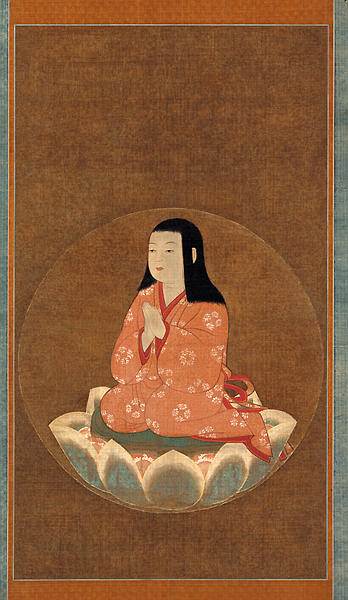稚児大師像
- 室町時代
- 14-15c
- 絹本著色
- H-74.2 W-42
- 所蔵
- 団琢磨旧蔵
室町時代 14-15世紀
絹本著色
縦:74.2cm 横:42.0cm
稚児大師というのは,弘法大師空海の幼少の頃の夢想を図示したものである。すなわち空海作に仮託されている『御遺告』のなかに,「吾れ昔生を得て父母の家に在りし時,生年五六の間,夢に常に八葉蓮華の中に居坐して諸仏と共に語ると見き」と記されている。これに基づく画像だが,とくに後宇多法皇が『弘法大師伝』を正和4年(1315)に撰述し,この段を美化して以降,画像化が進んだとみなされている。
背景がない空間に円相を描き,その中に蓮華座に坐る稚児姿の大師を表すという簡潔な図様である。黄白色の肉身に墨線の描き起こしとし,唇に朱をさす。小袖は桃色地に白の牡丹文と金泥の雲文を配している。蓮弁は緑青で弁脈には截金をあしらう。肉身部に補彩があるものの,全体の図様はよく保たれているといってよい。目や眉の描写には,やや固い印象を受け,室町時代前半の制作と判断される。もともとこの画題は古い作品がなく,本作品は早い部類に入るだろう。
付属の書付には「童形大師 男爵團琢磨殿御出品」という旧題簽があり,団家に伝えられた作品であることがわかる。(泉)
Catalogue Entry
Muromachi period, 14th to 15th centuries
Hanging scroll, color on silk
Height, 74.2cm; width, 42.0cm
Portraits of Kobo Daishi (Kukai 774-835) as a child show a 2-or-3-year-old child seated in meditation. The Goyuigo, traditionally ascribed to Kukai, notes the following: "I was born and lived in the home of my mother and father. When I was about 5-or-6-years old, I would normally see myself in my dreams seated in an eight-petal lotus blossom, conversing with the various Buddhas." While this pictorial iconography originally derived from this statement, we can also see how these images were further enhanced and made into a set pictorial iconography after this statement was included in the Retired Emperor Go-uda's Kobo Daishiden biography compiled in 1315 (Showa 4).
The simple composition of this iconography shows Kukai as a child seated in the middle of a lotus pedestal, placed within a round sphere floating against a blank background. With whitish-yellow flesh and black ink lines picking out the details of his features, the child's lips are painted with cinnabar red. The kosode kimono has a peach-colored ground and is decorated with white peonies and cloud patterns in gold paint. The lotus pedestal is malachite green with the petal veins picked out in cut gold leaf. Later brushwork can be seen on the body of the figure, but overall the integrity of the original image has been maintained. There is a somewhat hard sensibility in the depiction of the eyes and eyebrows, and this would indicate that the work was created in the first half of the Muromachi period. This subject matter was not taken up in older schools of Buddhist painting, and thus this work ranks among the early examples of this iconography.
One of the documents accompanying the painting reads "Kobo Daishi as a child, exhibited by Baron Dan Takuma" and thus clarifies that the work was transmitted through the Dan family. TI
